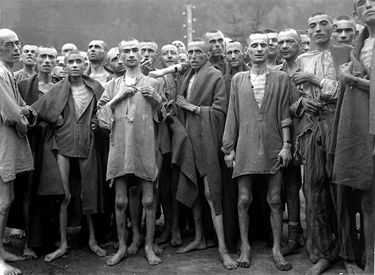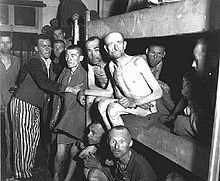Ebensee concentration camp
Coordinates: 47°47′15″N 13°45′28″E / 47.78750°N 13.75778°E

| Part of a series on | ||||||||||
| The Holocaust | ||||||||||
|---|---|---|---|---|---|---|---|---|---|---|
 | ||||||||||
|
||||||||||
|
||||||||||
|
Atrocities
|
||||||||||
|
Camps
|
||||||||||
|
Allied response |
||||||||||
|
Resources |
||||||||||
|
Remembrance
|
||||||||||
The Ebensee concentration camp was established by the SS to build tunnels for armaments storage near the town of Ebensee, Austria in 1943. It was part of the Mauthausen network.
Due to the inhumane working and living conditions, Ebensee was one of the worst Nazi concentration camps for the death rates of its prisoners. The SS used several codenames Kalk (English: limestone), Kalksteinbergwerk (English: limestone mine), Solvay and Zement (English: cement) to conceal the true nature of the camp.[1]
Formation
The construction of the Ebensee subcamp began late in 1943, and the first 1,000 prisoners arrived on November 18, 1943, from the main camp of Mauthausen and its subcamps. The main purpose of Ebensee was to provide slave labor for the construction of enormous underground tunnels in which armament works were to be housed. These tunnels were planned for the evacuated Peenemünde V-2 rocket development but, on July 6, 1944, Hitler ordered the complex converted to a tank-gear factory.[2]
Approximately 20,000 inmates were worked to death constructing giant tunnels in the surrounding mountains. Together with the Mauthausen subcamp of Gusen, Ebensee is considered one of the most horrific Nazi concentration camps.
Jews formed about one-third of the inmates, the percentage increasing to 40% by the end of the war, and were the worst treated, though all inmates suffered great hardships. The other inmates included Russians, Poles, Czechoslovaks, and Gypsies, as well as German and Austrian political prisoners and criminals.
The Commandant Otto Riemer (born May 19, 1897, date of death unknown) was a Nazi, a crew member of the Mauthausen-Gusen concentration camp, and SS-Obersturmführer. Unfortunately, his fate is unknown.[3] Another SS man was Alfons Bentele, who died in a French prison.
Conditions
Prisoners arose at 4:30 a.m. and worked until 6:00 p.m., constructing and expanding the tunnels. After some months the work was done in shifts covering 24 hours a day. There was almost no accommodation to protect the first batch of prisoners from the cold Austrian winter and deaths increased greatly. Bodies were piled in heaps and taken every three or four days to the Mauthausen crematorium to be burned, as Ebensee did not then have its own crematorium. The bodies of the dead were also piled inside the few huts that existed. The smell of the dead combined with the stenches of sickness, phlegm, urine, and faeces was said to be unbearable.
Prisoners wore wooden clogs, and went barefoot when the clogs fell apart. Lice infested the camp. In the morning, food rations consisted of half a liter of ersatz coffee; at noon, three quarters of a liter of hot water containing potato peelings; and, in the evening, 150 grams of bread. Due to such inadequate rations and the inhuman living conditions, beatings, and the onerous demands of the hard labor, the death toll continued to rise.
Liberation

As the Second World War in Europe came to an end, mass evacuations from other camps put tremendous pressure on the Mauthausen complex, the last remaining concentration camp in the area still controlled by the Nazis. The 25 Ebensee barracks had been designed to hold 100 prisoners each, but they eventually held as many as 750 each. To this number must be added the prisoners being kept in the tunnels or outdoors under the open sky.
The crematorium was unable to keep pace with the deaths and naked bodies were stacked outside the barrack blocks and the crematorium itself. In the closing weeks of the war, the death rate exceeded 350 a day. To reduce congestion, a ditch was dug outside the camp and bodies were flung into quicklime. On a single day in April 1945, a record 80 bodies were removed from Block 23 alone; in this pile, feet were seen to be twitching. During this period, the inmate strength reached a high of 18,000.
In May 1945, shooting in the distance could be heard from inside the camp and there was a sense among prisoners that American and British forces were close at hand. On May 4, 1945, the commandant of the camp informed prisoners that they had been sold to the Americans and that they should seek shelter in the camp's underground tunnels for protection. Prisoners refused and remained in their barracks; hours later some of the tunnels exploded, reputedly due to the detonation of mines. On May 5, 1945, prisoners awoke to find that the SS had deserted Ebensee and that only elderly Germans armed with rifles were guarding the camp.[4]
American troops of the US 80th Infantry Division arrived at the camp on May 6, 1945 - though for many inmates liberation came too late and they died of hunger, disease and exhaustion despite the efforts of American doctors to save them. Romanian-born Hermann Kahan was plucked alive from a pile of corpses, surviving to become a businessman in Norway.
Post-war commemoration
In the immediate aftermath of liberation, former Polish inmates erected a stark concrete monument on the mass graves of their fellow prisoners who did not survive. In the first decades after the war, however, no other commemoration efforts were undertaken. To the contrary, the site of the concentration camp was designated for development as a residential area; many of the remaining camp structures except for its gate were demolished. Moreover, during the 1960s a former SS officer for some time became mayor of Ebensee, without his Nazi past arousing much attention.
However, a drastically changed attitude followed in the wake of the 1988 election of Kurt Waldheim as President of Austria and the revelations of his Nazi career. Ebensee, like many other locations in Austria, was touched by the controversy and the need to face Austria's past.
In Ebensee there was a determination to commemorate the events and preserve what camp remnants were still there. The tunnels, which had been dug by the slave labourers, remained intact but they were neglected and their existence largely unknown.

In 1997 Mayor Herwart Loidl presided over the placing of memorial plaques in the tunnels, commemorating the severe hardships of the slave workers who built them, and to those who had died there. Access to the underground chambers was created through the stairs known as "Löwengang" (English: Lions' Walk). The tunnels since opening have seen increasing number of visitors, from abroad as well as Austrian students who are learning about their nation's past.
Today, a former school house has been turned into the Zeitgeschichte Museum und KZ-Gedenkstätte Ebensee, which holds regular lectures and readings, publishes a journal about the war period, and hosts an annual commemoration attended by surviving former inmates from different countries. It exhibits photographs, testimonies and relics from the camp. Nonetheless, the fact remains that many of the large satellite camps of the larger facilities as was the case for Ebensee, do not receive the attention they deserve and memorialization is comparatively scant.[5]
References
- ↑ "History of KZ Ebensee". Zeitgeschichte Museum und KZ-Gedenkstätte Ebensee. 2009-07-05.
- ↑ Irving, David (1964). The Mare's Nest. London: William Kimber and Co. p. 238.
- ↑ https://www.jewishvirtuallibrary.org/jsource/Holocaust/ebensee.html
- ↑ Moneta, Max. 1995. Max Moneta | Holocaust Survivor Interview & Testimony. Time index 1h22m5s. http://www.youtube.com/watch?v=DVXjwcbqIjI&feature=youtu.be&t=1h22m5s.
- ↑ Wachsmann & Caplan, eds. (2010). Concentration Camps in Nazi Germany: The New Histories, p. 202.
External links
- Zeitgeschichte Museum und KZ-Gedenkstätte Ebensee (English)
- Virtual Library Chapter on Ebensee Concentration Camp
- 3 photographic panoramas by Bernhard Vogl
- Underground Factory Projects - a virtual tour
- "Horror off the Beaten Track", The Jerusalem Report September 1, 2008
- KZ - Friedhof Ebensee 1,450 names at Find a Grave